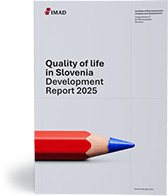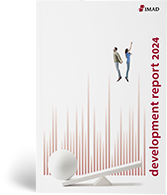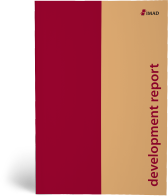Financial markets and prices
The financial crisis revealed a number of structural imbalances in the banking and corporate sectors. The beginning of the stabilisation and privatisation of banks was the first step in restructuring these sectors. In recent years, the financial system has operated in a context of a very expansionary monetary policy that has kept pace with the challenges of the economy. Central banks have responded to rising inflation by accelerating the normalisation of monetary policy, which poses an additional challenge to both economic activity and the maintenance of financial stability.
Quality of life in Slovenia – Development Report 2025
Slovenia ranks in the top half of EU Member States on most global composite indicators of quality of life.
In the area of social development, the gap between Slovenia and the EU in terms of the population's material well-being has narrowed in recent years, alongside positive developments on the labour market. Income, wealth and wage inequality remain among the lowest in the EU, as do the AROPE…
Development Report 2024
In Slovenia, a robust post-COVID-19 economic recovery, supported by improved conditions in trading partners and substantial fiscal policy measures, was followed by a slowdown in economic growth and an increase in inflation in 2022 and 2023 in the context of the energy crisis. The impact of rising cost pressures on competitiveness and the population's lower purchasing power was cushioned by…
Development Report 2023
The Slovenian economy recovered quickly from the epidemic, supported by an expansionary fiscal policy. GDP per capita in purchasing power standards reached 92% of the EU average last year, the highest level ever recorded. The measures taken to support the population during the epidemic and the period of rising energy prices significantly mitigated the impact of both crises on the social and…
Development Report 2022
Slovenia’s economy saw a quick rebound in 2021 with the help of massive government measures that kept the material and financial situation of the population relatively stable. The burden of the epidemic assumed by the government was reflected in a high general government deficit and an increase in general government debt, especially in 2020. The main challenge remains to overcome the development…
Development Report 2021
The Development Report, an annual publication prepared by the Institute of Macroeconomic Analysis and Development, which monitors the realisation of the Slovenian Development Strategy 2030, brings important recommendations for development policy. Short-term priorities continue to be highly related to preventing the spread of the covid-19 epidemic and mitigating its socio-economic consequences.…
Development Report 2020
In March 2020, a coronavirus epidemic was declared in Slovenia, which, with its enormous negative socio-economic impact on the economic and social situation, will significantly change the baselines for the realisation of the Slovenian Development Strategy 2030 (SDS), which is monitored by the Development Report – an annual publication prepared by the Institute of Macroeconomic Analysis and…
Development Report 2019
Since 2016 Slovenia has again been narrowing its development gap with the EU average, social inclusion of the population remains relatively high, while the efficiency of energy and resource consumption has improved somewhat. These are the key findings of this year’s Development Report of the Institute of Macroeconomic Analysis and Development. In certain areas, developments deviate from the…
Development Report 2018
Back on track to convergence with more developed Member States, Slovenia has been moving towards an inclusive society in the last few years; it has also reduced pressures on the environment. In certain areas developments have deviated significantly from the principles of sustainable development and pose a risk to the achievement of the SDS’s primary objective. To achieve the SDS’s central goal, it…
Slovenian Economic Mirror 6/2017
In Slovenia favourable developments continue in most sectors; the prospects also remain good. The labour market situation continues to improve under the impact of favourable economic conditions, while the growth of wages remains moderate. In October inflation was significantly lower than in previous months. The volume of loans to domestic non-banking sectors is rising further; the quality of…
Slovenian Economic Mirror 5/2017
This year activity is increasing in most activities and the prospects remain favourable. The labour market situation continues to improve under the impact of favourable economic conditions, while wage movements remain moderate. Year-on-year growth in consumer prices has been down again in the last few months. Amid favourable economic developments and moderate expenditure growth, the general…



